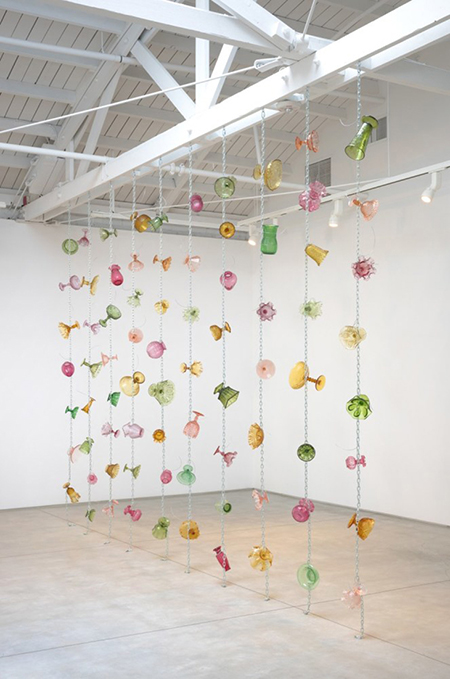
Continuing through October 28, 2023
There is an iconic scene in the 1999 movie “American Beauty” where a teenager screens a video he shot of a plastic bag slowly floating through the air, which he considers a moment of transcendent beauty. Whether or not Tony Feher (1956-2016) saw the film, he was on the same wavelength as filmmaker Alan Ball, who decided to create the scene after having an emotional response while watching a plastic bag blowing in the wind outside the World Trade Center for a full ten minutes. For his sculpture “New Myth” (2003), Feher suspended three partially air-filled and tied plastic bags, each a different color, from string. As light illuminates their crumpled exteriors, the empty bags seem weighty, richly tactile, mysterious as to their contents and metaphoric in their resemblance to intravenous (IV) drip bags hung next to a hospital patient’s bed. Although Feher was guided primarily by his aesthetic impulses, he was cognizant of such potential associations, as at age 33 he had a blood transfusion for a rare intestinal disease and, six weeks later, learned that he was HIV positive. He was also an active participant in the political group ACT UP (AIDS Coalition to Unleash Power).
Plastic bags are among several common materials from which Feher created a distinctive body of sculptural works using the street detritus of his New York City neighborhood. Much like Ball’s experience, Feher’s inspiration began with an epiphany when, in 1987, he was momentarily mesmerized by the array of colors he observed as light interacted with marbles seen through a storefront window. So he purchased some and, upon returning to the studio, made his first sculpture using a transparent container by arranging the marbles inside a honey jar. Throughout the remainder of his life (he died from liver cancer at age 60), Feher would explore a range of possibilities for compositions from glass or plastic jars and bottles. “Untitled (Vapor Line)” (2001-04) consists of twelve glass bottles with gold caps, aligned on a shelf and all of them empty save for moisture from water condensation tightly sealed inside each. Usually interpreted within the context of the AIDS era, the bottles could be human bodies with the last vestiges of their sweat and tears, while the caps suggest crowns or halos. In terms of composition, they form a horizontal line.
Feher’s love of Modernist abstraction is especially evident in “Sour Gem” (2007) and “Untitled” (2008). Installed on the floor, the former was made by stacking glass jars with metal lids, the size of the jars decreasing from bottom to top. While this sleek, elegant structure resembles a miniature tower, the progression of the lids creates a sequence of colorful lines and provides an element of discovery as we kneel to peer through the glass to observe the various patterns on the lids. The latter is a wall relief fashioned from plastic bottles filled with colored liquids and suspended from a calculated arrangement of string. Although constructed from utilitarian materials, the composition recalls the geometric abstractions of Kazimir Malevich and the Russian Constructivists.
In several works Feher calls attention to the dichotomy between the material and the spiritual. In “Birth Stone” (2008), everyday objects — green and opaque black glass bottles capped with red marbles — are clustered together in a circular arrangement that suggests a secret ceremony or a contemporary Stonehenge. The smashed Budweiser beer cans and loose change that form the bulk of the scatter piece “Constellation” (2007) are artifacts of consumer culture. Yet they also simulate the infinite universe, as indicated by the title and the reflective and thus celestial qualities of the metallic cans and coins and of the glass marbles placed atop the beer cans. A similar transformation can be seen in “Laying between Green and Violet #5” (2015), a construction made from blue painter’s tape stuck to Plexiglas that leans against a wall and is lit from the side by a light bulb. Structurally, the work resembles an emergency stretcher bed. At the same time, the illuminated tape functions something like a monochromatic stained glass window that resembles the 1950s cosmic abstractions of Lee Mullican.
Feher’s perspective on mortality is particularly evident in two installations that are profound and poignant musings on the joy and tenuousness of life itself. Like Christian Boltanski and fellow ACT UP member Felix Gonzalez-Torres, who used plugged-in light bulbs in their art to memorialize victims of the Holocaust and AIDS respectively, Feher found a metaphoric equivalency between electrical light and human existence. “Untitled” (2000) consists of a semi-circular floor arrangement of six groups of three light bulbs in the primary colors. Red, yellow, and blue were used along with black and white by the early 20th century Theosophist artist Piet Mondrian to represent his concept of a spiritual ideal. Installed in a dark room, Feher’s colored light bulbs flicker on and off at varying speeds, mimicking the rhythms of a human heartbeat. That the bulbs are colorful nevertheless lends a festive air, hinting that, while life may be temporary, it is to be enjoyed. Such a sentiment is also exhibited in “Parlour Trix” (2013), which simulates a curtain or partition made up of different colored glass goblets, bowls, and vases, evenly spaced and attached to nine long metal chains suspended from the ceiling. There is an abracadabra quality to these fragile, elegant vessels that appear to be levitating. Created just three years before Feher’s untimely demise, “Parlour Trix” is the ultimate toast to being alive.
